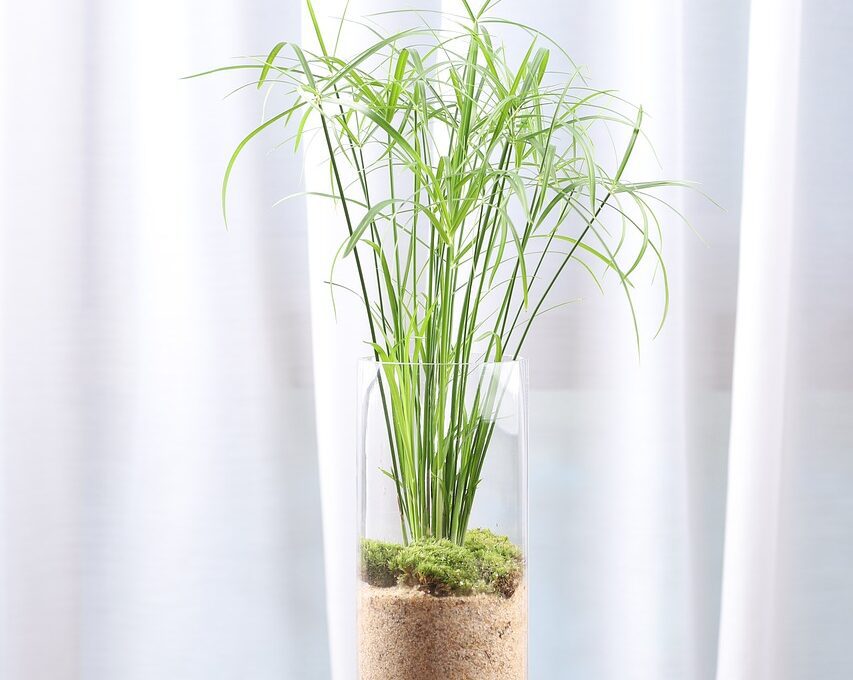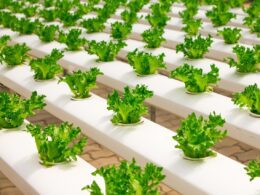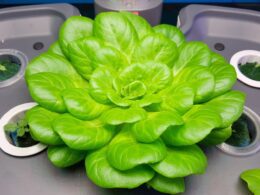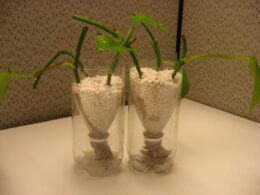Are you considering growing lettuce using hydroponics? If so, one of the crucial factors you need to consider is the depth of the lettuce roots. The depth of the lettuce roots determines how well the plant grows, and if not done correctly, it could lead to stunted growth or even death of the plant.
In this article, we will guide you on the ideal depth for lettuce roots in hydroponics and how to achieve it.
Hydroponics is a soilless farming technique that involves growing plants in a nutrient-rich water solution. This method has gained popularity in recent years due to its efficiency in producing high yields of healthy crops. However, unlike traditional farming, hydroponics requires a different approach to growing plants, and one of the critical factors to consider is the depth of the roots.
Whether you are a beginner or an experienced hydroponic farmer, understanding the ideal depth for lettuce roots is crucial for the success of your farming venture.
Understanding Hydroponics and Lettuce Growth
As you delve into the world of hydroponic farming and seek to optimize the growth of your leafy greens, it’s essential to understand the intricate relationship between nutrient solutions and plant development.
In a hydroponic system, plants grow in a nutrient-rich water solution instead of soil. This means that plants have to absorb all the necessary nutrients through their roots. This is why it’s important to provide the right balance of nutrients to the plants to ensure they grow healthy and strong.
Lettuce is a popular choice for hydroponic farming as it grows quickly and is easy to maintain. However, it’s important to note that lettuce has a shallow root system and doesn’t require a deep container or substrate. In fact, deep containers can lead to wasted nutrient solution as the roots won’t reach the bottom. Instead, a shallow container with a depth of 2-3 inches is sufficient for lettuce roots to spread out and absorb nutrients efficiently.
Nutrient uptake is crucial to the growth and development of lettuce in a hydroponic system. The roots of the lettuce absorb water and nutrients from the nutrient-rich water solution that is continuously circulated in the hydroponic system.
It’s important to monitor the pH level of the nutrient solution to ensure it’s within the optimal range for lettuce growth. Too high or too low pH levels can affect the plant’s ability to absorb nutrients and lead to stunted growth.
By understanding the nutrient uptake process and providing the right conditions for lettuce growth, you can ensure a bountiful harvest of healthy and delicious lettuce.
Factors Affecting Lettuce Root Depth
When it comes to lettuce root depth in hydroponics, there are several key factors to consider. The variety of lettuce you choose can play a significant role in determining how deep its roots will grow.
Additionally, the water and nutrient solution you use, as well as the temperature and lighting conditions in your hydroponic setup, can also impact root growth. By understanding these factors, you can create the optimal environment for your lettuce plants to thrive.
Lettuce Variety
Choosing the right variety of lettuce is important in ensuring that your hydroponic system yields healthy and robust plants. When it comes to lettuce variety selection, you need to consider the nutritional value analysis.
Different lettuce varieties have varying nutritional values, and some may be more suitable for hydroponic cultivation than others. For example, some varieties like butterhead lettuce have a lower nutritional value compared to other varieties like romaine lettuce. However, butterhead lettuce has a shorter growth cycle and is easier to grow, making it a good option for beginners.
Another factor to consider when selecting lettuce varieties is its root system. Some lettuce varieties have shallow roots, while others have longer and deeper roots. If you’re using a deep water culture hydroponic system, you need to choose lettuce varieties with longer and deeper roots.
This is because shallow-rooted varieties may not be able to absorb nutrients from the water efficiently, which can result in stunted growth and poor yields. On the other hand, lettuce varieties with longer and deeper roots can access nutrients more effectively, resulting in healthier and more robust plants.
Water and Nutrient Solution
To optimize the health and growth of your lettuce plants, it’s crucial to ensure that the water and nutrient solution you provide is well-balanced and regularly monitored in your hydroponic system. Here are some tips to help you achieve this goal:
- Use clean, filtered water to avoid any contaminants that could harm your plants.
- Keep track of the pH level of your water and nutrient solution, which should ideally be between 5.5 and 6.5 for lettuce. This will ensure that the plants can absorb the nutrients they need.
- Make sure that the nutrient solution is at the right concentration for lettuce, which is typically around 800-1000 ppm. Too much or too little can affect the plants’ growth.
- Be mindful of the plants’ nutrient uptake, which can be affected by factors such as temperature, humidity, and airflow. Adjust the nutrient solution accordingly to ensure that the plants are getting what they need.
- Regularly check the water and nutrient solution to ensure that it remains well-balanced and that the plants are thriving.
By following these guidelines, you can help your lettuce plants grow strong and healthy roots, which will in turn lead to a bountiful harvest. Remember to regularly monitor and adjust the water and nutrient solution to ensure that your plants are getting the optimal growing conditions.
Temperature and Lighting
Maintaining the proper temperature and lighting in your hydroponic setup is crucial for the success of your lettuce plants. Light intensity is important for the growth and development of your lettuce plants. Make sure to provide at least 14-16 hours of light per day and keep the light source at a distance of 6-12 inches from your plants. If the light source is too far, your plants won’t get enough light, and if it’s too close, it may cause leaf burn.
Humidity is also an important factor to consider. Lettuce plants thrive in a humidity range of 40-60%. If the humidity is too low, your plants may suffer from leaf tip burn, and if it’s too high, it may cause fungal diseases. Use a humidifier or a tray of water to maintain the proper humidity level.
Additionally, keep an eye on nutrient concentration and pH levels. pH levels should be between 5.5-6.5 for optimal growth, and nutrient concentration should be adjusted based on the growth stage of your plants.
By keeping these factors in check, you can ensure that your lettuce plants have the best chance of thriving in your hydroponic setup.
Ideal Depth for Lettuce Roots
You’ll want to make sure your lettuce is thriving by placing its roots at the perfect depth, which can be determined by considering the plant’s specific needs and the type of hydroponic system you’re using.
Here are four important factors to keep in mind when deciding on the ideal depth for your lettuce roots:
-
Oxygenation: Lettuce roots need access to oxygen in order to thrive, so it’s important to ensure they don’t get waterlogged. If the roots are submerged too deeply, they may not be able to access enough oxygen and could suffer from root rot.
-
Nutrient absorption: Just as important as oxygenation is nutrient absorption. The roots need to be able to reach the nutrient solution in order to absorb the necessary minerals. If the roots are too shallow, they may not be able to access enough nutrients, leading to stunted growth or nutrient deficiencies.
-
Hydroponic system type: Different types of hydroponic systems have different requirements for root depth. For example, in a deep water culture system, the roots can be suspended directly in the nutrient solution, while in a drip system, the roots need to be able to reach the drip lines.
-
Lettuce variety: Different varieties of lettuce have different root depths, so it’s important to choose a variety that is well-suited to your hydroponic system. For example, butterhead lettuce has shallower roots than romaine lettuce.
By taking all of these factors into account, you can determine the ideal depth for your lettuce roots. This will ensure that your plants are able to access the necessary oxygen and nutrients, and will help to promote healthy growth and a bountiful harvest.
So be sure to do your research and choose the best depth for your specific hydroponic setup and lettuce variety.
Is the White Stuff Growing on My Hydroponics Harmful to Lettuce Roots?
Hydroponic systems can sometimes develop a concerning issue: white stuff on hydroponics. This white substance, often identified as root rot or mold, can potentially harm lettuce roots. It is essential to address this problem promptly to prevent further damage and ensure the continued healthy growth of your hydroponic lettuce. Regular monitoring, proper sanitation, and implementing preventive measures can help maintain optimal conditions for root growth and reduce the risk of harm caused by the white stuff on hydroponics.
Techniques for Achieving Ideal Root Depth
Achieving the perfect root depth for your lettuce in a hydroponic system can be a fun and rewarding experience, and there are several techniques to help you do so.
One of the most effective techniques is root pruning. This involves trimming the roots of your lettuce to encourage new growth and prevent them from becoming too long and tangled. By pruning your roots, you can help your lettuce plants absorb more nutrients, which will ultimately result in healthier, stronger plants.
Another important technique for achieving ideal root depth is nutrient management. In a hydroponic system, nutrients are delivered directly to the roots of your plants. This means that it’s essential to carefully monitor the nutrient levels in your system to ensure that your lettuce is getting the nutrients it needs to thrive.
You can do this by using a nutrient solution that is specifically designed for lettuce, and by regularly testing the pH levels in your system to make sure they are within the optimal range.
Overall, achieving the perfect root depth for your lettuce in a hydroponic system requires a combination of careful root pruning and effective nutrient management. By following these techniques, you can create an optimal growing environment for your lettuce that will result in healthy, vibrant plants that provide you with a bountiful harvest. So if you’re looking to take your hydroponic gardening skills to the next level, be sure to give these techniques a try!
Monitoring and Maintaining Lettuce Root Depth
To ensure your lettuce plants are growing at their best, it’s important to regularly monitor and maintain their root depth. This means inspecting the roots on a regular basis to ensure they’re growing to the ideal depth.
If you notice any issues with root depth, you’ll need to take corrective measures to help your plants grow healthy and strong. And when it’s time to harvest your lettuce, you’ll need to replant and start the process all over again.
Regular Root Inspections
It’s crucial to regularly check on the health of your plants’ roots to ensure their success and maximize your yield. Regular root inspections will help you catch any problems early on, before they become larger issues that can affect the entire plant.
Checking the depth of your lettuce roots is an important part of this process. If your roots are too shallow, your plants may not be getting enough nutrients. This can lead to nutrient deficiencies and stunted growth.
On the other hand, if your roots are too deep, they may not be receiving enough oxygen, which can also cause problems. By regularly inspecting your lettuce roots and ensuring they are at the proper depth, you can help prevent these issues and keep your plants healthy and thriving.
Corrective Measures for Root Depth Issues
If you’re experiencing problems with your plant’s root depth, don’t worry – there are simple solutions to help correct the issue and get your plants back on track.
One option is root pruning, which involves cutting back excess roots to encourage the plant to grow new, healthier roots. This can be done by gently removing the plant from its container, trimming the roots with scissors or pruning shears, and replanting it in fresh, nutrient-rich hydroponic solution.
Another option is to address any nutrient deficiencies that may be contributing to poor root growth. Make sure you’re providing your plants with the right balance of nutrients, including nitrogen, phosphorus, and potassium.
You can also try adding a root growth stimulant to your hydroponic solution, which can help promote healthy root development. By taking these corrective measures, you can ensure that your lettuce plants are growing strong, healthy roots that will support their growth and development in your hydroponic system.
Harvesting and Replanting Lettuce
Harvesting and replanting your leafy greens is a satisfying and sustainable way to keep fresh produce on your plate. When it comes to harvesting lettuce in a hydroponic system, it’s important to use the right techniques to ensure that you don’t damage the roots. You should use a sharp knife or scissors to cut the leaves off at the base, leaving about an inch of the stem intact. This will allow the plant to continue growing and producing new leaves. Once you’ve harvested your lettuce, it’s time to replant. There are a few different strategies you can use, depending on the size of your system and the type of lettuce you’re growing.
To help you choose the right replanting strategy, take a look at the table below. It outlines the pros and cons of different techniques, as well as the best types of lettuce for each one. Remember to always handle your lettuce with care, and to give it plenty of water and nutrients to ensure healthy growth. With the right harvesting and replanting techniques, you’ll be able to enjoy fresh, delicious lettuce all year round.
| Replanting Strategy | Pros | Cons | Best Lettuce Types | |||||
|---|---|---|---|---|---|---|---|---|
| Direct Seeding | Easy to do | Takes longer to mature | Buttercrunch, Romaine | |||||
| Transplanting | Faster growth | Requires more work | Looseleaf, Oakleaf | |||||
| Continuous Harvest | Consistent supply | Requires careful maintenance | All types | Hydroponic | Year-round availability | Requires specialized equipment and knowledge | Bibb, Butterhead |
Frequently Asked Questions
What is the best type of hydroponic system for growing lettuce?
If you’re looking to grow lettuce hydroponically, you might be wondering which type of system is best. Two popular options are vertical farming and nutrient film technique (NFT).
While both can produce great results, they have some key differences. Vertical farming allows you to grow more plants in a smaller space, making it great for those with limited room. NFT, on the other hand, provides a continuous flow of nutrients to the plants, ensuring they get everything they need to grow healthy and strong.
Ultimately, the best choice for you will depend on your specific needs and preferences. So, whether you opt for vertical farming or NFT, you can rest easy knowing you’re giving your lettuce the best chance at success.
Can lettuce roots grow too deep in a hydroponic system?
To ensure that your lettuce roots don’t grow too deep in a hydroponic system, you may want to consider root pruning. This involves trimming the roots to a certain length, which can help promote healthier growth and better nutrient absorption.
When roots grow too long, they can become tangled and inhibit the plant’s ability to take in all the nutrients it needs. By pruning the roots, you can encourage a more efficient use of the available nutrients and prevent the roots from growing too deep.
This can also help prevent any potential safety hazards, as overly long roots can become entangled in the system and cause damage.
How often should I check and adjust the depth of my lettuce roots?
To ensure the health and productivity of your hydroponic lettuce, it’s important to regularly monitor and prevent the overgrowth of its roots. By doing so, you can prevent issues such as root rot and nutrient deficiencies.
Checking the depth of your lettuce roots should be done frequently, ideally on a weekly basis. This involves gently lifting the plant and examining the roots to ensure they are not growing too long or tangling together. If you notice any issues, adjust the depth of the roots by carefully loosening or tightening the grow medium around the roots.
By keeping a close eye on your lettuce roots, you can help ensure a successful harvest and a thriving hydroponic system.
Are there any supplements or nutrients that can help promote optimal root depth in lettuce?
To promote optimal root depth in lettuce, consider incorporating hydroponic nutrients and root depth enhancers into your system. These supplements can help provide the necessary nutrients and stimulate root growth, ultimately leading to healthier and stronger plants.
By utilizing these tools, you can ensure that your lettuce is able to absorb the necessary water and nutrients for optimal growth. Keep in mind that while these supplements can be helpful, it’s still important to regularly check and adjust the depth of your lettuce roots to ensure they’re reaching the appropriate level.
With the right care and attention, you can help your lettuce thrive in a hydroponic system.
What are some common mistakes to avoid when trying to achieve ideal lettuce root depth in hydroponics?
When it comes to achieving ideal lettuce root depth in hydroponics, there are some common mistakes that you should avoid.
One of the biggest mistakes is not pruning the roots enough. Root pruning is crucial in promoting healthy growth in hydroponic lettuce, as it helps prevent overgrowth and allows for better nutrient uptake.
Another mistake to avoid is not maintaining proper nutrient levels. If the nutrient levels are too high or too low, this can lead to stunted growth and poor root development.
Finally, make sure to keep the water temperature at the right level, as temperatures that are too high or too low can also hinder root growth.
By avoiding these common mistakes, you can ensure that your hydroponic lettuce has healthy, strong roots that will lead to a bountiful harvest.
Conclusion
So, how deep should lettuce roots be in hydroponics? The answer is that it depends on various factors, such as the type of lettuce, the growing medium, and the system being used. However, the ideal depth for lettuce roots in hydroponics is between 1-2 inches.
To achieve this depth, techniques such as using a net pot, a deep-water culture system, or a drip irrigation system can be employed. Additionally, monitoring and maintaining the root depth by regularly checking the water level and adjusting the system as necessary is crucial for optimal plant growth.
Remember, maintaining the proper depth for lettuce roots in hydroponics is essential for a healthy and thriving crop. By understanding the factors affecting root depth and using the appropriate techniques, you can ensure that your lettuce plants reach their maximum potential.









